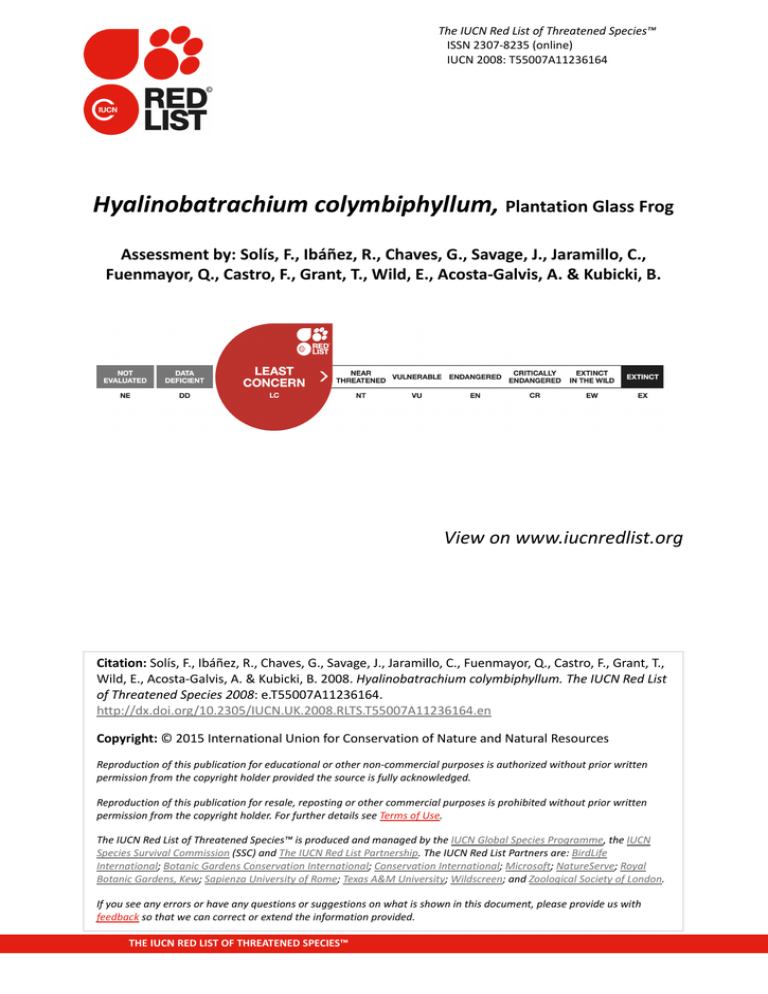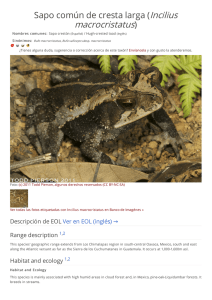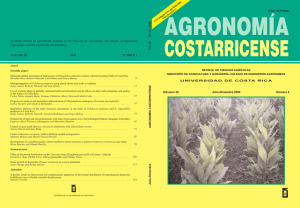assessment
Anuncio

The IUCN Red List of Threatened Species™ ISSN 2307-8235 (online) IUCN 2008: T55007A11236164 Hyalinobatrachium colymbiphyllum, Plantation Glass Frog Assessment by: Solís, F., Ibáñez, R., Chaves, G., Savage, J., Jaramillo, C., Fuenmayor, Q., Castro, F., Grant, T., Wild, E., Acosta-Galvis, A. & Kubicki, B. View on www.iucnredlist.org Citation: Solís, F., Ibáñez, R., Chaves, G., Savage, J., Jaramillo, C., Fuenmayor, Q., Castro, F., Grant, T., Wild, E., Acosta-Galvis, A. & Kubicki, B. 2008. Hyalinobatrachium colymbiphyllum. The IUCN Red List of Threatened Species 2008: e.T55007A11236164. http://dx.doi.org/10.2305/IUCN.UK.2008.RLTS.T55007A11236164.en Copyright: © 2015 International Union for Conservation of Nature and Natural Resources Reproduction of this publication for educational or other non-commercial purposes is authorized without prior written permission from the copyright holder provided the source is fully acknowledged. Reproduction of this publication for resale, reposting or other commercial purposes is prohibited without prior written permission from the copyright holder. For further details see Terms of Use. The IUCN Red List of Threatened Species™ is produced and managed by the IUCN Global Species Programme, the IUCN Species Survival Commission (SSC) and The IUCN Red List Partnership. The IUCN Red List Partners are: BirdLife International; Botanic Gardens Conservation International; Conservation International; Microsoft; NatureServe; Royal Botanic Gardens, Kew; Sapienza University of Rome; Texas A&M University; Wildscreen; and Zoological Society of London. If you see any errors or have any questions or suggestions on what is shown in this document, please provide us with feedback so that we can correct or extend the information provided. THE IUCN RED LIST OF THREATENED SPECIES™ Taxonomy Kingdom Phylum Class Order Family Animalia Chordata Amphibia Anura Centrolenidae Taxon Name: Hyalinobatrachium colymbiphyllum (Taylor, 1949) Synonym(s): • Centrolenella colymbiphyllum Taylor, 1949 • Cochranella colymbiphyllum (Taylor, 1949) Common Name(s): • English: • Spanish: Plantation Glass Frog Ranita De Cristal Taxonomic Source(s): Frost, D.R. 2013. Amphibian Species of the World: an Online Reference. Version 5.6 (9 January 2013). Electronic Database. American Museum of Natural History, New York, USA. Available at: http://research.amnh.org/herpetology/amphibia/index.html. Taxonomic Notes: Taxonomic revision of this species is needed, with the population in Monteverde, Costa Rica, possibly representing an undescribed species (Brian Kubicki pers. comm.). Assessment Information Red List Category & Criteria: Least Concern ver 3.1 Year Published: 2008 Date Assessed: January 1, 2008 Justification: Listed as Least Concern in view of its wide distribution, presumed large population, and because it is unlikely to be declining fast enough to qualify for listing in a more threatened category. Previously Published Red List Assessments 2004 – Least Concern (LC) Geographic Range Range Description: This species is known from the humid lowlands, premontane slopes, and lower areas of the lower montane belt of the Atlantic slope of Costa Rica, and the Pacific slope marginally in northwestern Costa Rica and from southwestern Costa Rica also on the Atlantic versant in central Panama (up to 1,580m asl). Some records from the Caribbean slope of Costa Rica may refer to Hyalinobatrachium chirripoi (Brian Kubicki pers. comm.). In Colombia it is known from Tolima, Caldas, Boyaca, Cordoba, Antioquia, © The IUCN Red List of Threatened Species: Hyalinobatrachium colymbiphyllum – published in 2008. http://dx.doi.org/10.2305/IUCN.UK.2008.RLTS.T55007A11236164.en 1 Risaralda, Choco and Valle del Cauca departments up to 1,800m asl. Country Occurrence: Native: Colombia; Costa Rica; Panama © The IUCN Red List of Threatened Species: Hyalinobatrachium colymbiphyllum – published in 2008. http://dx.doi.org/10.2305/IUCN.UK.2008.RLTS.T55007A11236164.en 2 Distribution Map © The IUCN Red List of Threatened Species: Hyalinobatrachium colymbiphyllum – published in 2008. http://dx.doi.org/10.2305/IUCN.UK.2008.RLTS.T55007A11236164.en 3 Population It is generally a common species throughout its range. The population declined drastically in Monteverde, Costa Rica, by early in the 1990s, but it has since partially recovered. Current Population Trend: Stable Habitat and Ecology (see Appendix for additional information) It inhabits humid lowland and montane forest, and is observed in bushes and trees along forest streams. The larvae develop in these streams. It is restricted to the vegetation over the streams. Systems: Terrestrial, Freshwater Threats General habitat loss due to the destruction of natural forests is a localized threat, but there are no major threats to the species overall survival at present. Conservation Actions (see Appendix for additional information) The species has been recorded from a number of protected areas throughout its range. Credits Assessor(s): Solís, F., Ibáñez, R., Chaves, G., Savage, J., Jaramillo, C., Fuenmayor, Q., Castro, F., Grant, T., Wild, E., Acosta-Galvis, A. & Kubicki, B. Reviewer(s): Stuart, S.N., Chanson, J.S., Cox, N.A. & Young, B.E. © The IUCN Red List of Threatened Species: Hyalinobatrachium colymbiphyllum – published in 2008. http://dx.doi.org/10.2305/IUCN.UK.2008.RLTS.T55007A11236164.en 4 Bibliography Barrera-Rodriguez, M. 2000. Estudio anatomico de cuatro especies de ranitas de cristal del genero Hyalinobatrachium Ruiz & Lynch 1991 grupo fleischmanni (Amphibia: Centrolenidae). Revista de la Academia Colombiana de Ciencias Exactas, Físicas y Naturales: 245-260. Hayes, M.P. 1981. A study of clutch attendence in the neotropical frog Centrolenella fleischmanni (Anura: Centrolenidae). Ph.D. Dissertation, University of Miami. Ibañez, R., Rand, A.S. and Jaramillo, C.A. 1999. Los anfibios del Monumento Natural Barro Colorado, Parque Nacional Soberanía y areas adyacentes. Mizrachi, E. and Pujol, S.A., Santa Fe de Bogota. Ibáñez, R., Solís, F., Jaramillo, C. and Rand, S. 2000. An overwiew of the herpetology of Panama. In: J.D. Johnson, R.G. Webb and O.A. Flores-Villela (eds), Mesoamerican Herpetology: Systematics, Zoogeography and Conservation, pp. 159-170. The University of Texas at El Paso, El Paso, Texas. IUCN. 2008. 2008 IUCN Red List of Threatened Species. Available at: http://www.iucnredlist.org. (Accessed: 5 October 2008). Jaramillo, F.E., Jaramillo, C.A. and Ibanez, R. 1997. Renacuajo de la rana de cristal Hyalinobatrachium colymbiphyllum (Anura: Centrolenidae). The tadpole of Hyalinobatrachium colymbiphyllum (Anura: Centrolenidae). Revista de Biologia Tropical: 867-870. Kubicki, B. 2007. Ranas de vidrio Costa Rica = Glass frogs of Costa Rica. Instituto Nacional de Biodiversidad, INBio. McDiarmid, R.W. 1978. Evolution of parental care in frogs. In: Burghardt, G.M. and Bekoff, M. (eds), The development of behaviour: Comparative and evolutionary aspects, pp. 127-147. Garland STPM Press, New York. Pounds, J.A., Fogden, M.P.L., Savage, J.M. and Gorman, G.C. 1997. Tests of null models for amphibian declines on a tropical mountain. Conservation Biology 11: 1307-1322. Ruiz-Carranza, P.M. and Lynch, J.D. 1991. Ranas Centrolenidae de Colombia I. Propuesta de una nueva clasificación genérica. Lozania (Acta Zoológica colombiana): 1-30. Ruiz-Carranza, P.M. and Lynch, J.D. 1998. Ranas Centrolenidae de Colombia XI. Nuevas especies de ranas cristal del género Hyalinobatrachium. Revista de la Academia Colombiana de Ciencias Exactas, Físicas y Naturales: 571-586. Ruiz-Carranza, P.M., Ardila-Robayo, M.C. and Lynch, J.D. 1996. Lista actualizada de la fauna de Amphibia de Colombia. Revista de la Academia Colombiana de Ciencias Exactas, Físicas y Naturales 20(77): 365415. Savage, J.M. 2002. The Amphibians and Reptiles of Costa Rica: A Herpetofauna between two Continents, between two Seas. University of Chicago Press, Chicago. Young, B., Sedaghatkish, G., Roca, E. and Fuenmayor, Q. 1999. El Estatus de la Conservación de la Herpetofauna de Panamá: Resumen del Primer Taller Internacional sobre la Herpetofauna de Panamá. The Nature Conservancy, Arlington, Virginia. Citation Solís, F., Ibáñez, R., Chaves, G., Savage, J., Jaramillo, C., Fuenmayor, Q., Castro, F., Grant, T., Wild, E., Acosta-Galvis, A. & Kubicki, B. 2008. Hyalinobatrachium colymbiphyllum. The IUCN Red List of © The IUCN Red List of Threatened Species: Hyalinobatrachium colymbiphyllum – published in 2008. http://dx.doi.org/10.2305/IUCN.UK.2008.RLTS.T55007A11236164.en 5 Threatened Species 2008: e.T55007A11236164. http://dx.doi.org/10.2305/IUCN.UK.2008.RLTS.T55007A11236164.en Disclaimer To make use of this information, please check the Terms of Use. External Resources For Images and External Links to Additional Information, please see the Red List website. © The IUCN Red List of Threatened Species: Hyalinobatrachium colymbiphyllum – published in 2008. http://dx.doi.org/10.2305/IUCN.UK.2008.RLTS.T55007A11236164.en 6 Appendix Habitats (http://www.iucnredlist.org/technical-documents/classification-schemes) Habitat Season Suitability Major Importance? 1. Forest -> 1.6. Forest - Subtropical/Tropical Moist Lowland - Suitable - 1. Forest -> 1.9. Forest - Subtropical/Tropical Moist Montane - Suitable - 5. Wetlands (inland) -> 5.1. Wetlands (inland) - Permanent Rivers/Streams/Creeks (includes waterfalls) - Suitable - Conservation Actions in Place (http://www.iucnredlist.org/technical-documents/classification-schemes) Conservation Actions in Place In-Place Land/Water Protection and Management Conservation sites identified: Yes, over entire range Conservation Actions Needed (http://www.iucnredlist.org/technical-documents/classification-schemes) Conservation Actions Needed 2. Land/water management -> 2.1. Site/area management Research Needed (http://www.iucnredlist.org/technical-documents/classification-schemes) Research Needed 1. Research -> 1.1. Taxonomy 1. Research -> 1.2. Population size, distribution & trends 1. Research -> 1.3. Life history & ecology Additional Data Fields Distribution Upper elevation limit (m): 1800 © The IUCN Red List of Threatened Species: Hyalinobatrachium colymbiphyllum – published in 2008. http://dx.doi.org/10.2305/IUCN.UK.2008.RLTS.T55007A11236164.en 7 Population Population severely fragmented: No © The IUCN Red List of Threatened Species: Hyalinobatrachium colymbiphyllum – published in 2008. http://dx.doi.org/10.2305/IUCN.UK.2008.RLTS.T55007A11236164.en 8 The IUCN Red List Partnership The IUCN Red List of Threatened Species™ is produced and managed by the IUCN Global Species Programme, the IUCN Species Survival Commission (SSC) and The IUCN Red List Partnership. The IUCN Red List Partners are: BirdLife International; Botanic Gardens Conservation International; Conservation International; Microsoft; NatureServe; Royal Botanic Gardens, Kew; Sapienza University of Rome; Texas A&M University; Wildscreen; and Zoological Society of London. THE IUCN RED LIST OF THREATENED SPECIES™



